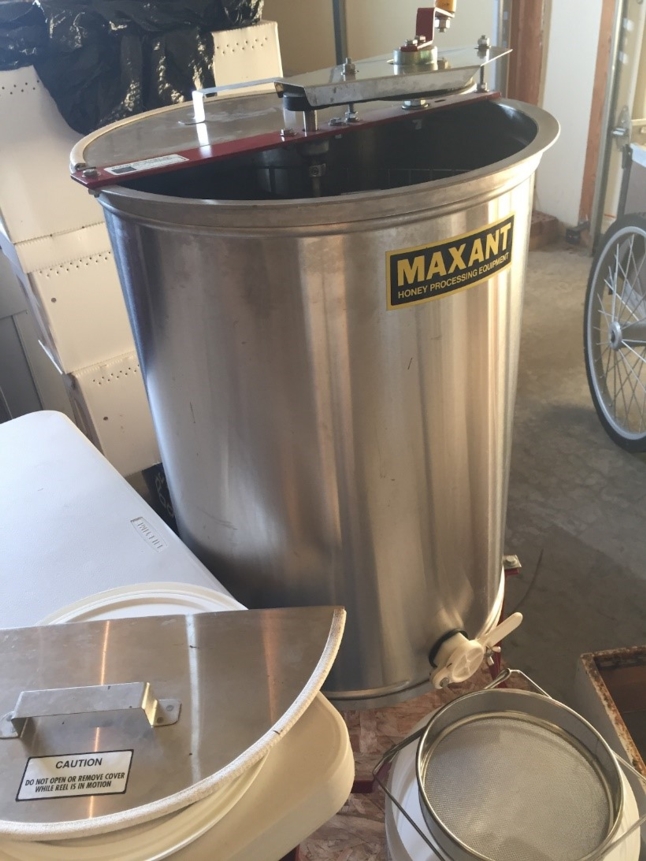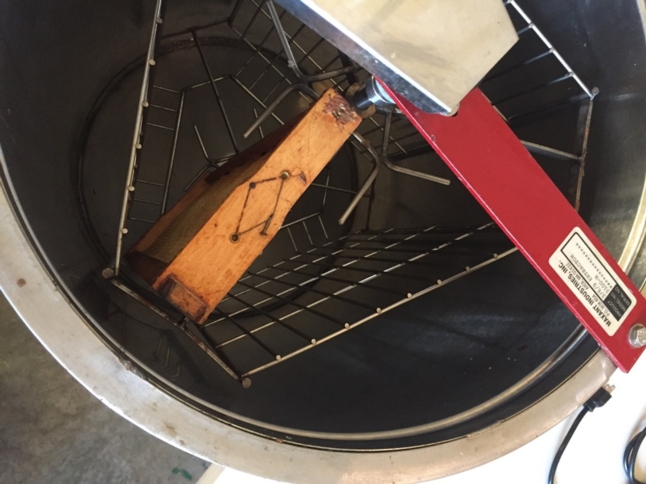Extractor Lending Program
Beekeepers of the Northern Shenandoah Extractor Lending Program
For many new beekeepers and those who keep just one or a couple of hives, buying your own extractor in the first year or two is not warranted and knowing what you want in an extractor is difficult without ever going through the process of extracting. This lending program is designed to allow our members to take advantage of a small honey harvest in their first year or two, and have the “extraction experience”. We know buying an extractor is not something everyone wants to do so this may help you overcome that expense.
BONS now has a second extractor that can be used at your home as a loaner. It will be kept at the home of Doug Koch who lives near Winchester Medical Center. You will need to contact him for pickup and drop off. He will review the process, details on using it and return. There is no fee for using the extractor, just a $50 deposit returned upon return with no damage. We expect it will be returned in the same shape you received it.
 Extractors handle honey, and there is a small possibility of disease transfer by dirty extractors or other honey handling equipment if it is not properly disinfected between use. For this reason, it is important to thoroughly clean the extractor. We will explain how to sanitize it. No contact with bees should be allowed after this cleaning (i.e. -don’t leave it outside to dry).
Extractors handle honey, and there is a small possibility of disease transfer by dirty extractors or other honey handling equipment if it is not properly disinfected between use. For this reason, it is important to thoroughly clean the extractor. We will explain how to sanitize it. No contact with bees should be allowed after this cleaning (i.e. -don’t leave it outside to dry).
We are planning a period of 4 days for borrowing. Pick up day one, extract day two, clean day 3 and return day 4. If no one else is planning to use it then it may be available one more day.
Things you will provide and need ready before you pick up the extractor:
Food Grade buckets/lids; Normal sizes are 4-5 gallons. Every 3-4 frames = one gallon. Never fill more than two thirds of the bucket full. It has happened that the weight is too much and picking up by the handle has caused a very messy spill.
Doing this on a tarp is helpful but not necessary. If you have a garage this is a good spot but if you don’t have one, you will want to be in a screen tent where foraging bees will not come and try to take the honey back.
You will also need a table to work on, a container for warm water, a few cloths, (things do get sticky), container/bucket for wet cappings, the bees will clean these up and dry them out for you afterwards.
If you have a family member or friend to help with the uncapping while one is spinning an extra rectangular bin is helpful which can hold the uncapped frames while the spinning is happening. If you are doing this alone then you will uncap and put them directly into the extractor.
Once you are finished spinning, the frames go back into an empty hive body, probably the one you took off the hive or just another one. It is common that not all frames in each box are fully capped so you take out just what is fully capped. You can leave the space empty for one or two days. Then you will return the wet frames for them to clean up and rebuild the wax you carved out. Below you will see a suggestion on putting back 9 frames in a 10 frame super or 7 in an 8 frame super to let them draw out deeper frames for next year's extraction.
Things we provide: Extractor 6 frame hand crank; cappings tank; hot knife; honey fork; filter (2). https://www.maxantindustries.com/extractors.html
Operating the extractor:
1. Ensure the honey gate is open and a bucket (YOU PROVIDE) with a filter is directly under the honey gate the entire time the extractor is operating. Our extractor is secured to a piece of plywood for stability.
2. Uncapped frames should be placed in the baskets in a manner that they do not move or fall (see picture).
 3. Slow rotation to start will prevent heavy honey frames from “blowing out”.
3. Slow rotation to start will prevent heavy honey frames from “blowing out”.
4. After extracting all frames, tipping the extractor and propping it up at an angle can facilitate getting the last honey out of the bottom of the machine. It must not be rotating when this is done.
5. Clean the extractor by spraying down with water (outside is ok for this, realizing that bees will be attracted to the smell of honey. Work fast and/or do it at sunset/dark. DO NOT SCRUB WITH ABRASIVES OR STEEL WOOL as this can scratch the surfaces making future cleanings difficult or in-effective. A final thorough rinse with very hot water will be helpful. Upon return Doug will inspect it and sanitize it. The same process can and should be used on all equipment borrowed.
Here’s some more information about the extractor https://www.maxantindustries.com/pdfs/3100HandExtractor_Instruction.pdf
We also own an electric uncapping knife. Here are some instructions on how to use it:
How to use the uncapping knife:
To use, simply plug in a clean knife. CAUTION; Knife will get hot!
Unplug to turn off and cool. Clean blade with while still warm (see 6 below.)
There’s a short helpful video here: https://www.youtube.com/watch?v=F2d0o8oaV0g and a longer one here : https://www.youtube.com/watch?v=1iqfW_0EHVw
UNCAPPING INSTRUCTIONS
- To remove the beeswax cap on each cell, uncap with either an upward or downward motion allowing the wax cappings to fall away from the knife blade. Remove just enough of the beeswax to allow the honey to come out, as this will minimize the work the bees will need to do to repair and refill these honey cells. Use an uncapping stroke that will not strike any part of your body. Some honey processors use a slight sawing motion while cutting off the beeswax caps. CAUTION-AVOID INJURY: If you uncap with an upward stroke, be sure to keep your other hand AND thumb that is holding the frame of honeycomb out of the path of the knife. Knife is sharp and gets hot! Work safely when uncapping so you don’t cut or burn yourself. Develop an uncapping stroke that will allow you to uncap an entire side of a frame in a single stroke using the frame itself as a guide for the knife. Develop deeper honeycomb cells to make your uncapping easy.*
- Cool knife as needed by plunging the blade into a pile of uncapping. Set your hot knife only on a nonflammable, no melt surface if you set it down.
- Use the entire length of the blade to distribute the heat of the knife evenly across the work surface for your best uncapping results. Use the pointed end of the knife to get into corners and score difficult to reach areas on the comb. Fatter combs are easy to process with this tool*
- Uncapping Honey is a sticky process. Plan in advance how to keep your work area clean as you work. You can use damp cloth towels to keep the work tools and uncapping area clean. Plan your uncapping workflow to make it easy on yourself. Your tools should be ready and clean; the work area clean and well lighted and all items ready within easy reach. Do not track honey on your shoes. Keeping the mess to a minimum helps avoid unnecessary clean up and explanations! You may wish to use an uncapping tub to capture the wax scraps and honey when you are processing your honey.
- Never use the knife as a prying tool to pry frames out. Clean knife before and after each use with a damp, but not wet cloth.
- Clean the knife when the knife is warm as a warm knife is easiest to clean. Keep the knife clean for best results. Never immerse the knife in water – it will ruin the knife.
- Use caution when handling the knife, it is capable of both burning and cutting your skin!
Always unplug the knife when not in use. Never leave the knife plugged in for extended periods or leave it plugged in when you are not present.
Caution: Be cautious to prevent accidentally searing the electric cord with the knife. Inspect and clean the knife before and after each use and do not use it if wires are frayed. Keep out of reach of children.
*How to get deeper honeycomb cells in the future? Create deeper cells by reducing the number of frames in a 10 frame super to 9 frames evenly spaced, but only after the bees have drawn out the frames and you have uncapped the honey. Use these processed frames as the bees’ templates for deeper honeycomb cells. Deeper honeycombs mean fewer frames and less work for the beekeeper or honey processor. Let the bees draw out the comb before going to 9 frames to help prevent disorganized comb building and extra burr comb.